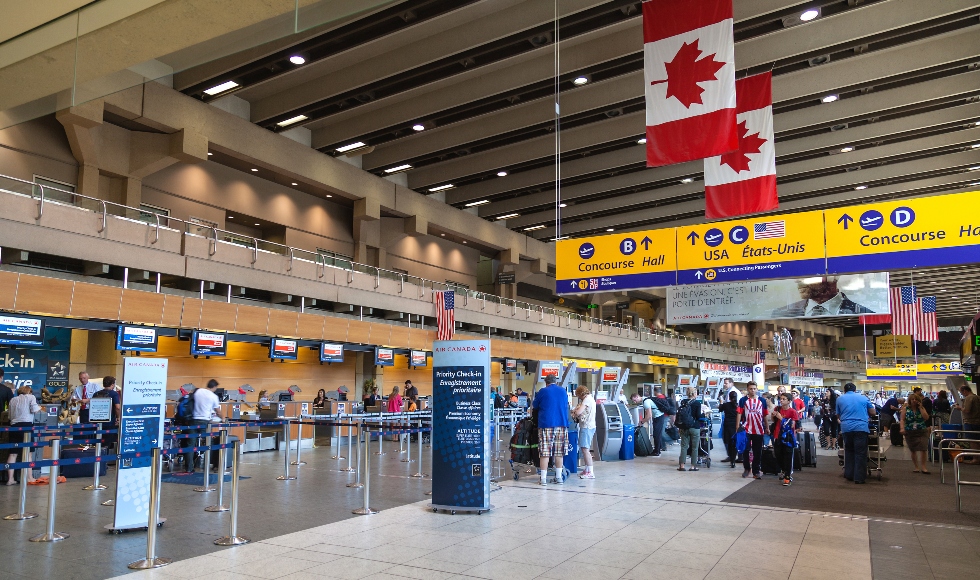Canada’s changing coronavirus border policy exposes international students’ precarious status

Canada’s announcements about its border have not left international students with a sense of security. Photo by Shutterstock
BY Carlo Handy Charles
March 20, 2020
Canada’s border closure announcements have thrown international students and other foreign nationals on a roller coaster of anxiety that jeopardizes many people’s sense of wellness and security.
Since U.S. President Donald Trump’s travel ban on citizens of countries with substantial Muslim populations in 2017, Canada has strengthened its position as a welcoming country for international students. In 2017, there were close to 500,000 international students studying in Canada.
However, on March 16, Prime Minister Justin Trudeau announced that Canada will take aggressive measures to limit the spread of COVID-19. He said Canada would deny “entry to Canada to people who are not Canadian citizens or permanent residents,” except Americans.
This announcement raised concerns about why Canada chose to keep its border open to Americans since the United States is Canada’s top source of international tourists: in 2015 more than 22 million Americans vacationed in Canada.
Then, two days later, on March 18, Trudeau announced that U.S. travellers will no longer be permitted to cross the border for “recreation and tourism,” saying that in both countries, citizens are encouraged to stay home.
Amid a flurry of ensuing anxious social media posts from foreign residents, including many international students, Public Safety Minister Bill Blair said international students, workers with visas and temporary foreign workers will be allowed to enter Canada but will need to self-isolate for 14 days.
But both in the short term, as officials at many levels respond to changing circumstances and messaging, and over the longer term, as our society adapts to the pandemic, it’s far from clear that Canada’s announcements will provide international students or temporary foreign workers with a sense of security.
Some international students or temporary residents at the border were blocked from coming back to Canada on Monday, Radio Canada reported.
And, on March 18, the Government of Canada officially published a list of people who are exempted from this measure. However, this list does not explicitly mention whether international students or temporary foreign workers are allowed to return to Canada if they are currently abroad.
Key concerns remain unaddressed. How effectively has, or will, Canada communicate its border decisions about international students and temporary foreign workers to border officials, airlines and the students themselves? Do these changing messages in a short time signal that international students should be concerned for the future of their mobility and their studies? How is the well-being of international students and other temporary residents in Canada impacted by wondering if the border could be closed to them?
Potential consequences
It is important to understand how temporary residents — those without permanent residency — such as international students, temporary foreign workers and other precarious status foreigners who have been legally living, studying and working in Canada for months or years — have been affected by these announcements.
Research conducted in Ontario shows that it is important to pay particular attention to how living with precarious legal status may impact the well-being and feelings of belonging and social support of children and families.

Will international students, foreign workers or the Canadian public now be wondering whether temporary residents have become disposable foreigners amid COVID-19 pandemic? Indeed, as they were not addressed in Trudeau’s initial announcement, they may be wondering whether their temporary resident status is worthy of Canadian state consideration and protection or it is an item that can be disposed of in times of crisis.
It is understandable that the federal government’s aggressive measures aim to protect Canadians and permanents residents of Canada. It is also clear that “we are in a fairly critical period” to slow the spread of COVID-19, as Canada’s Chief Public Health Officer Dr. Theresa Tam said.
And it’s more than clear that we should follow the federal government’s recommendations of social distancing to limit the spread of the virus.
However, talking about closing the border to those who have lived, studied and worked in Canada for months or years raises concerns about how we should help each other amid the COVID-19 pandemic while respecting human rights and dignity.
Respecting human rights
As the United Nations High Commissioner for Refugees recommended, states are of course entitled to take measures to ascertain and manage risks to public health, including risks that could arise in connection with non-nationals arriving at their borders. Such measures must be non-discriminatory as well as necessary, proportionate and reasonable with the aim of protecting public health.
Canada’s border closure contradicts WHO’s recommendations, which urge all countries to “strike a fine balance between protecting health, minimizing economic and social disruption and respecting human rights.”
South Korea, for example, has been recognized for implementing efficient testing, quarantine and tracking measures to slow the spread of COVID-19 without implementing a lockdown.
Relief measures?
What protection and relief measures can international students and temporary foreign workers expect from the federal government as conditions surrounding the pandemic change?
The federal government has, after all, announced that no Canadian should be worried about rent payments, groceries and additional child care because it will help Canadians financially during the COVID-19 pandemic.
International students are clearly concerned about their precarious situations. Will Canada offer any official relief measures or supports for international students too, like rent relief?

Precarious status and well-being
The prime minister’s announcement of Canada’s border closure to all foreigners may have had a significant impact on the mental and physical health of international students who are temporary residents in Canada, and have been living and working in the country.
Students’ health and wellness may have been affected by knowing that if they leave the country, they will not be able to come back to continue their studies, research or work. This may also impact the Canadian economy.
In 2015 and 2016, respectively, international students in Canada spent about $12.8 billion and $15.5 billion on tuition, accommodation and discretionary spending. How will the federal government’s changing messaging on the Canadian welcome to international students affect the Canadian economy in the future?
Canadian compassion
Amid the COVID-19 pandemic, Canada has shown compassion to the most vulnerable people. For instance, the federal government halted deportations of precarious status foreigners with the exception of serious criminal cases.
However, Canada’s initial lack of consideration for international students and other temporary residents when it announced it was closing the border seems jarringly ill-conceived and insensitive given the country’s constant effort to recruit international students to continue enhancing Canada’s national economy and international reputation.
Even though it was corrected two days later, Canada’s decisions and messaging prompt us to reflect on how we should apply measures of social distancing that are not harmful to others and that still protect human dignity — and to consider how we should account for and help each other in times of crisis. We’re also prompted to think about how we should address popular concerns while remaining caring, thoughtful and welcoming to others.![]()
Carlo Handy Charles, Teaching and Research Assistant and Joint Ph.D. Student in Sociology and Geography, McMaster University
This article is republished from The Conversation under a Creative Commons license. Read the original article.


